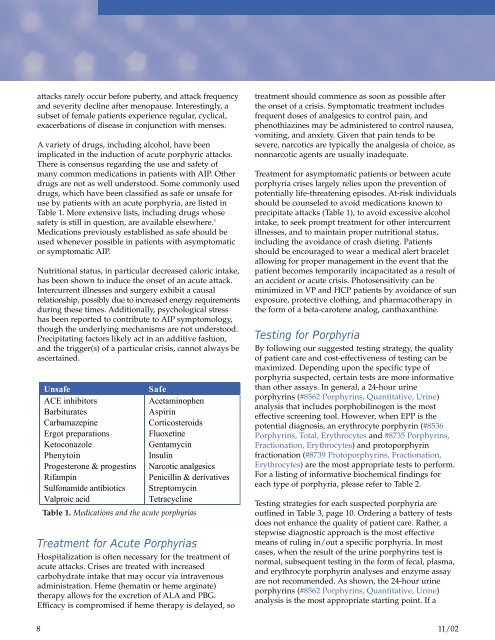The Challenges Of Testing For And Diagnosing Porphyrias
The Challenges Of Testing For And Diagnosing Porphyrias
The Challenges Of Testing For And Diagnosing Porphyrias
You also want an ePaper? Increase the reach of your titles
YUMPU automatically turns print PDFs into web optimized ePapers that Google loves.
attacks rarely occur before puberty, and attack frequency<br />
and severity decline after menopause. Interestingly, a<br />
subset of female patients experience regular, cyclical,<br />
exacerbations of disease in conjunction with menses.<br />
A variety of drugs, including alcohol, have been<br />
implicated in the induction of acute porphyric attacks.<br />
<strong>The</strong>re is consensus regarding the use and safety of<br />
many common medications in patients with AIP. Other<br />
drugs are not as well understood. Some commonly used<br />
drugs, which have been classified as safe or unsafe for<br />
use by patients with an acute porphyria, are listed in<br />
Table 1. More extensive lists, including drugs whose<br />
safety is still in question, are available elsewhere. 3<br />
Medications previously established as safe should be<br />
used whenever possible in patients with asymptomatic<br />
or symptomatic AIP.<br />
Nutritional status, in particular decreased caloric intake,<br />
has been shown to induce the onset of an acute attack.<br />
Intercurrent illnesses and surgery exhibit a causal<br />
relationship, possibly due to increased energy requirements<br />
during these times. Additionally, psychological stress<br />
has been reported to contribute to AIP symptomology,<br />
though the underlying mechanisms are not understood.<br />
Precipitating factors likely act in an additive fashion,<br />
and the trigger(s) of a particular crisis, cannot always be<br />
ascertained.<br />
Table 1. Medications and the acute porphyrias<br />
Treatment for Acute <strong>Porphyrias</strong><br />
Hospitalization is often necessary for the treatment of<br />
acute attacks. Crises are treated with increased<br />
carbohydrate intake that may occur via intravenous<br />
administration. Heme (hematin or heme arginate)<br />
therapy allows for the excretion of ALA and PBG.<br />
Efficacy is compromised if heme therapy is delayed, so<br />
treatment should commence as soon as possible after<br />
the onset of a crisis. Symptomatic treatment includes<br />
frequent doses of analgesics to control pain, and<br />
phenothiazines may be administered to control nausea,<br />
vomiting, and anxiety. Given that pain tends to be<br />
severe, narcotics are typically the analgesia of choice, as<br />
nonnarcotic agents are usually inadequate.<br />
Treatment for asymptomatic patients or between acute<br />
porphyria crises largely relies upon the prevention of<br />
potentially life-threatening episodes. At-risk individuals<br />
should be counseled to avoid medications known to<br />
precipitate attacks (Table 1), to avoid excessive alcohol<br />
intake, to seek prompt treatment for other intercurrent<br />
illnesses, and to maintain proper nutritional status,<br />
including the avoidance of crash dieting. Patients<br />
should be encouraged to wear a medical alert bracelet<br />
allowing for proper management in the event that the<br />
patient becomes temporarily incapacitated as a result of<br />
an accident or acute crisis. Photosensitivity can be<br />
minimized in VP and HCP patients by avoidance of sun<br />
exposure, protective clothing, and pharmacotherapy in<br />
the form of a beta-carotene analog, canthaxanthine.<br />
<strong>Testing</strong> for Porphyria<br />
By following our suggested testing strategy, the quality<br />
of patient care and cost-effectiveness of testing can be<br />
maximized. Depending upon the specific type of<br />
porphyria suspected, certain tests are more informative<br />
than other assays. In general, a 24-hour urine<br />
porphyrins (#8562 Porphyrins, Quantitative, Urine)<br />
analysis that includes porphobilinogen is the most<br />
effective screening tool. However, when EPP is the<br />
potential diagnosis, an erythrocyte porphyrin (#8536<br />
Porphyrins, Total, Erythrocytes and #8735 Porphyrins,<br />
Fractionation, Erythrocytes) and protoporphyrin<br />
fractionation (#8739 Protoporphyrins, Fractionation,<br />
Erythrocytes) are the most appropriate tests to perform.<br />
<strong>For</strong> a listing of informative biochemical findings for<br />
each type of porphyria, please refer to Table 2.<br />
<strong>Testing</strong> strategies for each suspected porphyria are<br />
outlined in Table 3, page 10. Ordering a battery of tests<br />
does not enhance the quality of patient care. Rather, a<br />
stepwise diagnostic approach is the most effective<br />
means of ruling in/out a specific porphyria. In most<br />
cases, when the result of the urine porphyrins test is<br />
normal, subsequent testing in the form of fecal, plasma,<br />
and erythrocyte porphyrin analyses and enzyme assay<br />
are not recommended. As shown, the 24-hour urine<br />
porphyrins (#8562 Porphyrins, Quantitative, Urine)<br />
analysis is the most appropriate starting point. If a<br />
8 11/02

















